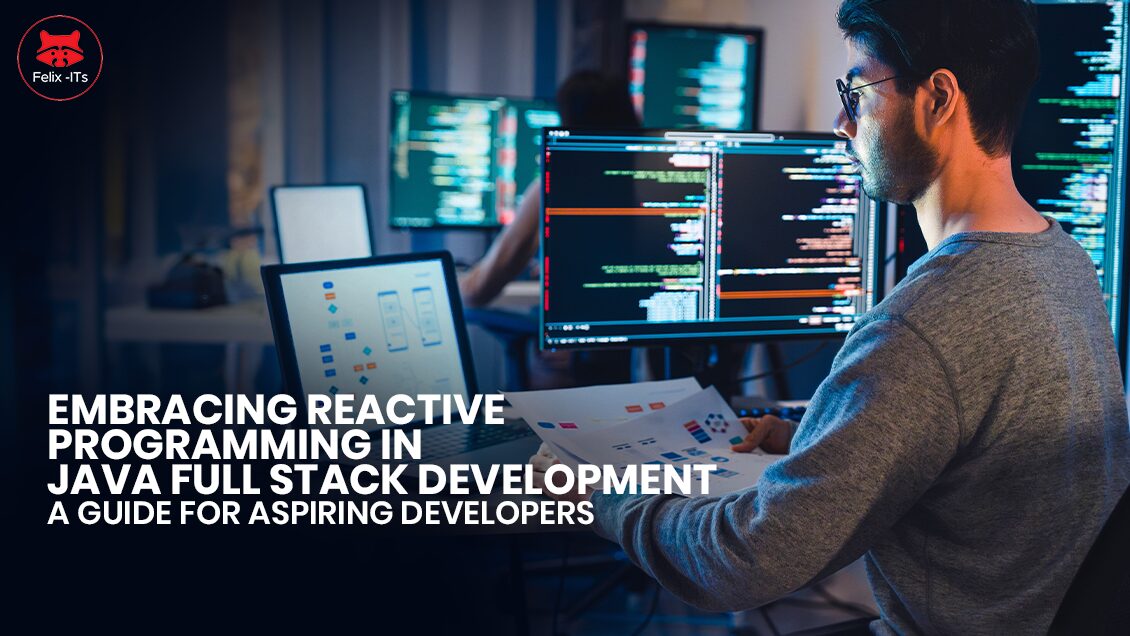Reactive programming is transforming how we build responsive and resilient applications in today’s fast-paced tech environment. For aspiring Java full-stack developers, understanding reactive programming is crucial for staying ahead in the competitive job market. This blog will delve into the latest trends in reactive programming with Java, its benefits, and how to integrate it into your full-stack development projects.
What is Reactive Programming?
Reactive programming is an asynchronous programming paradigm concerned with data streams and the propagation of change. It enables developers to build applications that are more flexible, loosely coupled, and scalable. Reactive programming is particularly useful for applications that require high performance and real-time data processing.
Why Reactive Programming with Java?
Java has robust support for reactive programming, making it an ideal choice for full-stack development. Here’s why you should consider adopting reactive programming in your Java projects:
- Asynchronous and Non-blocking: Reactive programming allows for asynchronous and non-blocking operations, enhancing application performance and responsiveness.
- Scalability: Handle multiple requests simultaneously without the overhead of traditional multi-threading.
- Resilience: Build systems that can recover gracefully from failures, providing a better user experience.
- Stream Processing: Efficiently manage and process continuous streams of data.
Key Technologies and Frameworks
1. Project Reactor
Project Reactor is a fully non-blocking foundation with efficient demand management, making it ideal for building reactive applications. It is tightly integrated with the Spring framework, allowing seamless adoption in Spring Boot applications.
- Mono: Represents a single asynchronous value or error.
- Flux: Represents a sequence of asynchronous values.
2. Spring WebFlux
Spring WebFlux is a reactive web framework in the Spring ecosystem. It supports reactive programming with Project Reactor and other reactive libraries.
- RouterFunction: Functional programming model for routing HTTP requests.
- WebClient: Non-blocking, reactive HTTP client for performing HTTP requests.
3. Reactive Streams
A standard for asynchronous stream processing with non-blocking backpressure. It defines a common set of interfaces and methods for handling asynchronous data streams.
Practical Example: Building a Reactive Chat Application
To illustrate the power of reactive programming in Java full-stack development, let’s build a simple reactive chat application. This application will allow users to send and receive messages in real-time.
Step 1: Setting Up the Project
Using Spring Boot and Spring WebFlux, we’ll set up our reactive chat application.
Dependencies: Add Spring Boot Starter WebFlux and Reactor dependencies to your `pom.xml`.
Step 2: Creating Reactive Endpoints
Define reactive endpoints to handle real-time chat messages using Spring WebFlux.
- ChatController: Manages HTTP requests related to chat messages.
- RouterConfiguration: Configures routing for chat endpoints.
“`java
@Bean
public RouterFunction<ServerResponse> route(ChatHandler handler) {
return RouterFunctions
.route(GET(“/chat”), handler::getMessages)
.andRoute(POST(“/chat”), handler::postMessage);
}
“`
Step 3: Implementing Reactive Services
Create reactive services to handle the business logic for our chat application.
- ChatService: Manages chat messages using reactive data types.
“`java
@Service
public class ChatService {
private final List<ChatMessage> messages = new ArrayList<>();
public Flux<ChatMessage> getMessages() {
return Flux.fromIterable(messages);
}
public Mono<Void> postMessage(Mono<ChatMessage> message) {
return message.doOnNext(messages::add).then();
}
}
“`
Step 4: Front-End Integration
Use WebSocket to enable real-time communication between the client and the server.
- WebSocket Configuration: Set up WebSocket endpoints in Spring Boot.
- JavaScript Client: Use JavaScript to connect to the WebSocket server and handle real-time messages.
“`javascript
const socket = new WebSocket(‘ws://localhost:8080/chat’);
socket.onmessage = function(event) {
const message = JSON.parse(event.data);
displayMessage(message);
};
“`
Step 5: Testing and Deployment
Test the application to ensure it handles real-time messaging efficiently. Deploy the application using **Docker** for consistent deployment across different environments.
- Dockerfile: Create a Dockerfile to build the Docker image for your chat application.
- docker-compose.yml: Set up Docker Compose for multi-container deployment if needed.
Conclusion
Reactive programming is revolutionizing how we build modern applications. For Java full stack developers, mastering reactive programming with Spring WebFlux and Project Reactor is essential for developing high-performance, scalable, and resilient applications. This knowledge not only enhances your skill set but also makes you a strong candidate in job interviews and the competitive tech industry.
At Felix IT Systems, we offer comprehensive training in Java Full Stack Development, including in-depth modules on reactive programming. Our courses are designed to equip you with the latest skills and knowledge to excel in your career. Join us in Pune, Mumbai, Thane, or Ahmedabad and become a proficient full-stack developer today.


